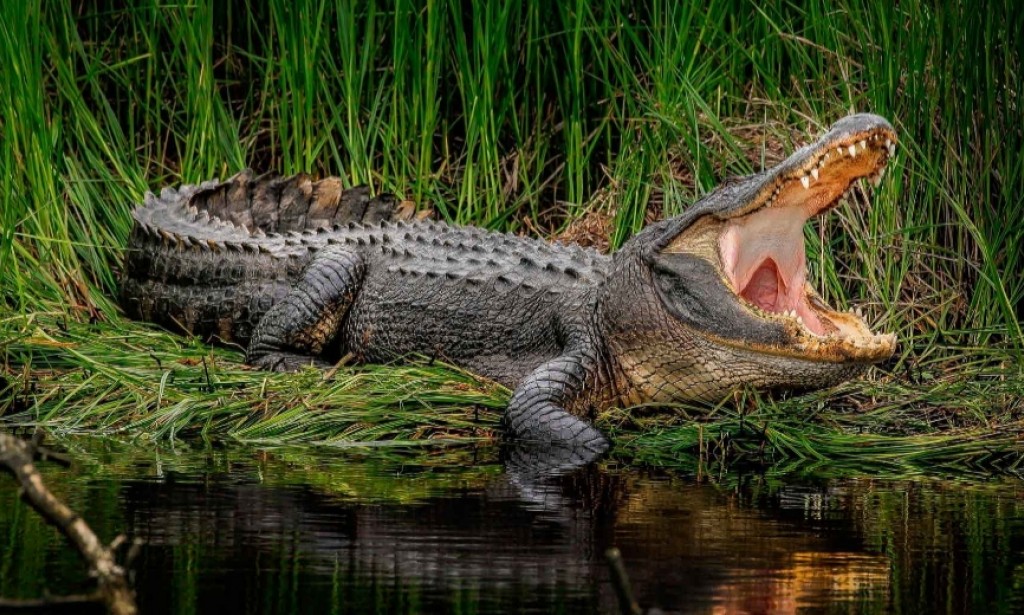The Nile crocodile looks intimidating and belongs to the Crocodile family. It is huge, very strong and well camouflaged. The predator has short paws that are located on the sides of the body, scaly skin, a long, ridged tail, and powerful jaws. The crocodile's eyes, ears, and nostrils are at the top of the head. The reptile has remarkably good hearing and vision. The Nile crocodile looks inconspicuous because of its coloration. Young individuals are usually gray or light brown in color and have dark stripes on the back and tail. The older the individual becomes, the darker the coloration becomes.
The stomach of the reptile has a yellow tint. The massive muscular tail of the Nile crocodile serves as a sort of gas pedal and allows it to move quickly in the water. It occupies almost half the length of the reptile's entire body. The jaw of the Nile crocodile has 65 teeth and is one of the strongest on the planet. The predator can easily hold large animals and crush the bone. Due to the sensory organs on the top of the head, the crocodile can almost completely immerse itself in water. This allows the animal to camouflage itself by lurking in the water, leaving only its eyes and the tip of its nose on the surface, while its large and long body is hidden underwater. The Nile crocodile looks massive and is the largest crocodile. This predator is the second largest crocodile in the world. Male Nile crocodiles greatly outnumber females in size. The average size of adult males ranges from 3 to 5 meters in length. At the same body weight ranges from 300 to 700 kg. Individual males can reach over 6 meters in length and weigh over a ton. The average size of females ranges from 2 to 4 meters, with a body weight of 200 to 500 kg. But individual larger females are also found. Where does the Nile crocodile live? Features of behavior The Nile crocodile lives in Africa and is one of the continent's largest crocodiles.
It inhabits freshwater lakes, rivers and swamps almost all over the African continent. It is most common in such African countries as Kenya, Somalia, Zambia and Ethiopia. Nile crocodile population is quite high and stable, but in some countries of the continent this species is threatened with extinction. The Nile crocodile lives in calm water, with a sandy coastal area. It is not often that it can be found at a considerable distance from a body of water. This is usually due to the search for a new habitat, and if the reservoir dries up. Most often, the crocodile crawls on its stomach, but can run short distances at speeds of up to 14 km / h. The Nile crocodile is very skilled and successful at swimming. He usually dives for 2-3 minutes, but can stay underwater for 30 minutes to 2 hours. It submerges completely and silently, forcing the air out of its large lungs. The Nile crocodile swims very fast underwater. The tail helps to develop speed in the water up to 30 km / h. His ears, nose and throat are protected by valves, and the eye is covered with a thin transparent film.
This predator has special receptors throughout the body. Thanks to which he easily picks up vibrations of water, and finds with what force and where they come from. The Nile crocodile lives unhurriedly - usually they are rather slow creatures, like many other cold-blooded animals. They spend most of their time on the shore or in shallow water, keeping their jaws open to avoid overheating. Also the opening of the jaws is a sign of threat to other crocodiles. Nile crocodiles are very hostile and territorial predators. Crocodiles can go into summer hibernation, which lasts from May to August. To do this, they dig a hole in the riverbank. Once underground, where it is dark and cool, the animal's body temperature drops and its metabolism, breathing and heartbeat slow down. In this state, energy is consumed as little as possible. In this way, the crocodile can conserve enough energy until it needs it. For centuries, the great Nile crocodile has lived on the planet, causing terror because it can kill animals and humans instantly and brutally. Among other animals, the Nile crocodile has no enemies. Only humans are opposed to the predator. The Nile crocodile is hunted because of its skin. The Nile crocodile, combining its large size and high level of aggression, creates a very high probability of attacking humans. The Nile crocodile lives near undeveloped populations and often makes contact with humans. It can attack a person when standing in the water by the shore, crossing shallow water, crossing a body of water, or launching its legs into the water from a boat or pier.



You must be logged in to post a comment.